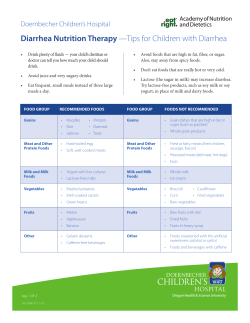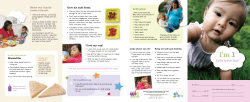
Eating Healthy on a College Budget
Healthy Eating on a Budget Eating Healthy on a College Budget As a college student, you might find it difficult to eat healthy on a budget. Take advantage of refrigerators, microwaves, and stoves in dorm rooms and apartments to prepare healthy foods that cost less than eating in the cafeteria. Keep reading for tips for making healthier choices on a college campus. In Your Dorm Room Your dorm room or hall might have a microwave, mini-fridge, and hot plate. Use them to make easy breakfasts and grab-and-go snacks that can help you save cash. Here are some quick and easy ideas: • Buy bulk bags of whole grain cereal, dried fruit, and dry-roasted or raw nuts. Store in clear plastic or glass jars so you will see these foods when you’re thinking about what to eat. • If you find yourself throwing away fresh milk that is past its “use by” date, buy nonfat dry milk instead. It costs less and lasts longer. Or buy small containers of perishable foods like milk and yogurt. • For breakfast or a snack, microwave a bowl of quick-cooking oats mixed with low-fat milk or water. Add 2 tablespoons of dried fruit or chopped nuts for extra flavor. • At the store or farmer’s market, look for less-expensive fresh fruit, such as apples, oranges, bananas, and pears. In-season fruits are usually less costly. • Buy lower sodium, canned soups instead of dried noodle soups (such as ramen), which are loaded with salt. • Enjoy any of these sandwiches for a quick lunch or dinner: ◦◦ Deli meat on 100% whole wheat bread with tomato and mustard ◦◦ Peanut butter and jelly on whole grain bread ◦◦ Sliced cheese and sliced tomato inside a whole wheat pita Copyright 2011 American Dietetic Association. This handout may be reproduced for patient education. 1 Healthy Eating on a Budget In Your Apartment Kitchen If you know where to shop and what foods to buy, you can save a lot of money by cooking in your apartment. Here are some tips to get you started: • Look for a discount supermarket in your area. Sign up for a free membership card to get store coupons and discounts. • Bring reusable shopping bags to the grocery store every time you shop. Many stores offer discounts to customers who provide their own bags. • To manage your time wisely, set aside an hour a week to write a shopping list. Having a list with you at the market will also help you avoid impulse purchases. • Fresh meat, fish, and chicken can be costly. Instead, choose lower priced protein foods, such as tuna canned in water, eggs, and peanut butter. If possible, choose natural peanut butter instead of brands with added sugars and fats. • Invest in a small coffee maker or buy instant coffee instead of going out for overpriced coffee at the local coffee shop. • Skip snacks with added fat and sugars, such as cookies, cakes, and chips. Instead, choose healthier snacks like whole wheat pretzels, fruit, vegetables, nuts, low-fat yogurt, and low-fat cheese sticks. • Have a potluck dinner with friends. Suggest a healthy dish to each person. Enjoy the company of your friends while saving money on food. • Pop your own popcorn instead of buying microwave popcorn. (Try the recipe below.) Easy Air-Popped Popcorn Place ¼ cup unpopped popcorn kernels in a brown paper lunch bag. Tightly fold over the top of the bag several times. Microwave on high for about 2 minutes, or until the popping slows. Enjoy the popcorn plain, or add a sprinkle of salt. Copyright 2011 American Dietetic Association. This handout may be reproduced for patient education. 2
© Copyright 2025





















